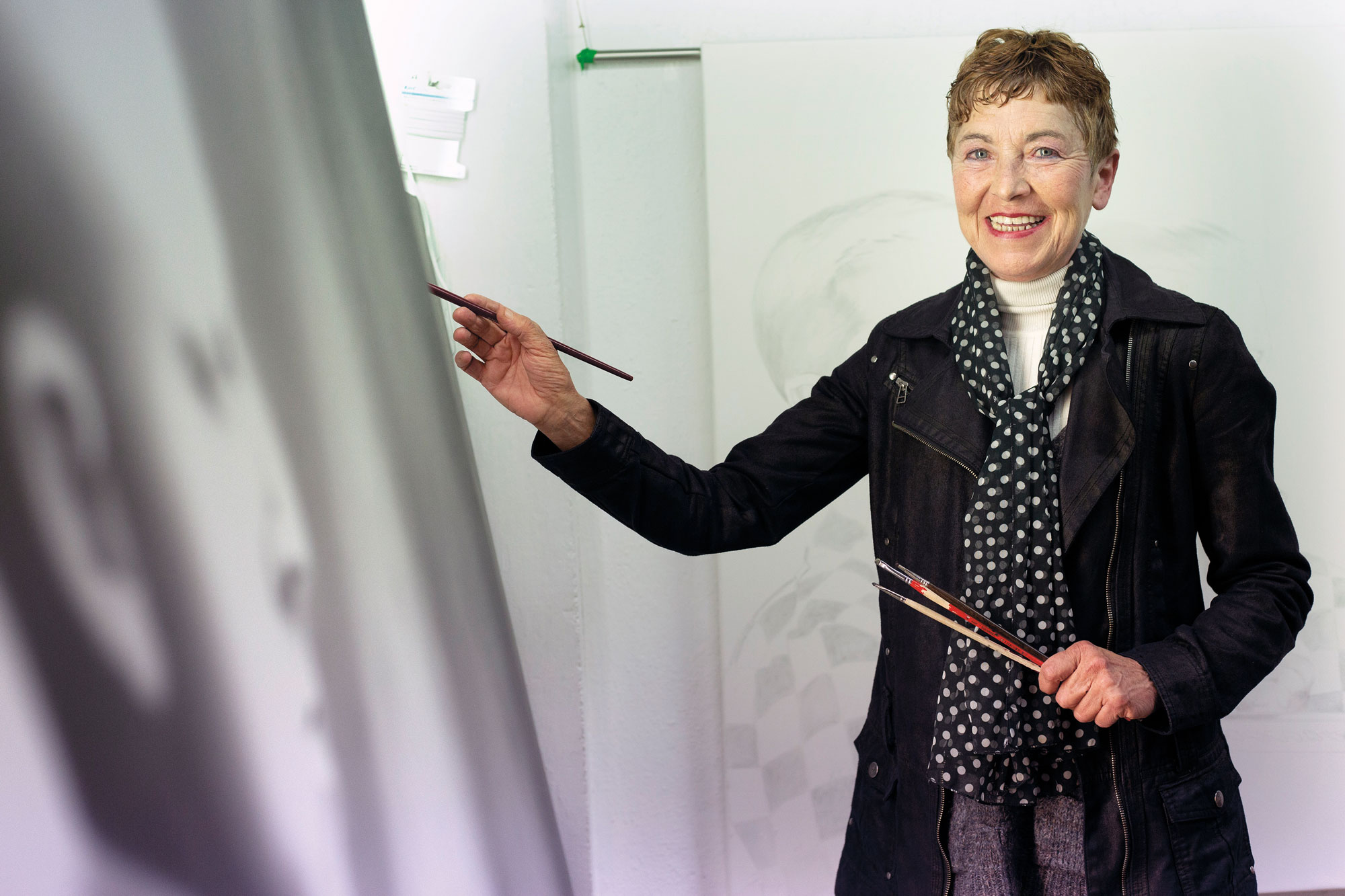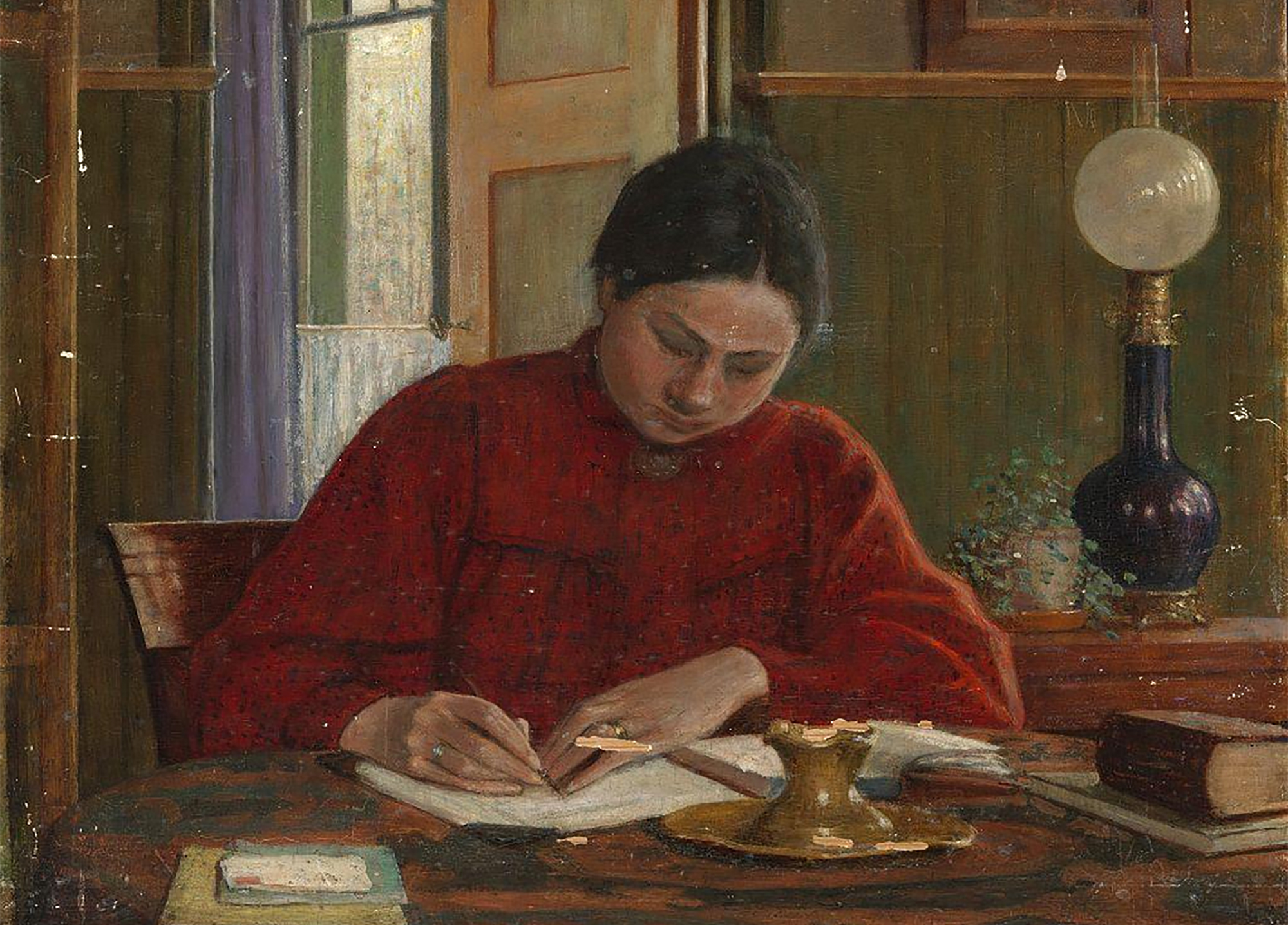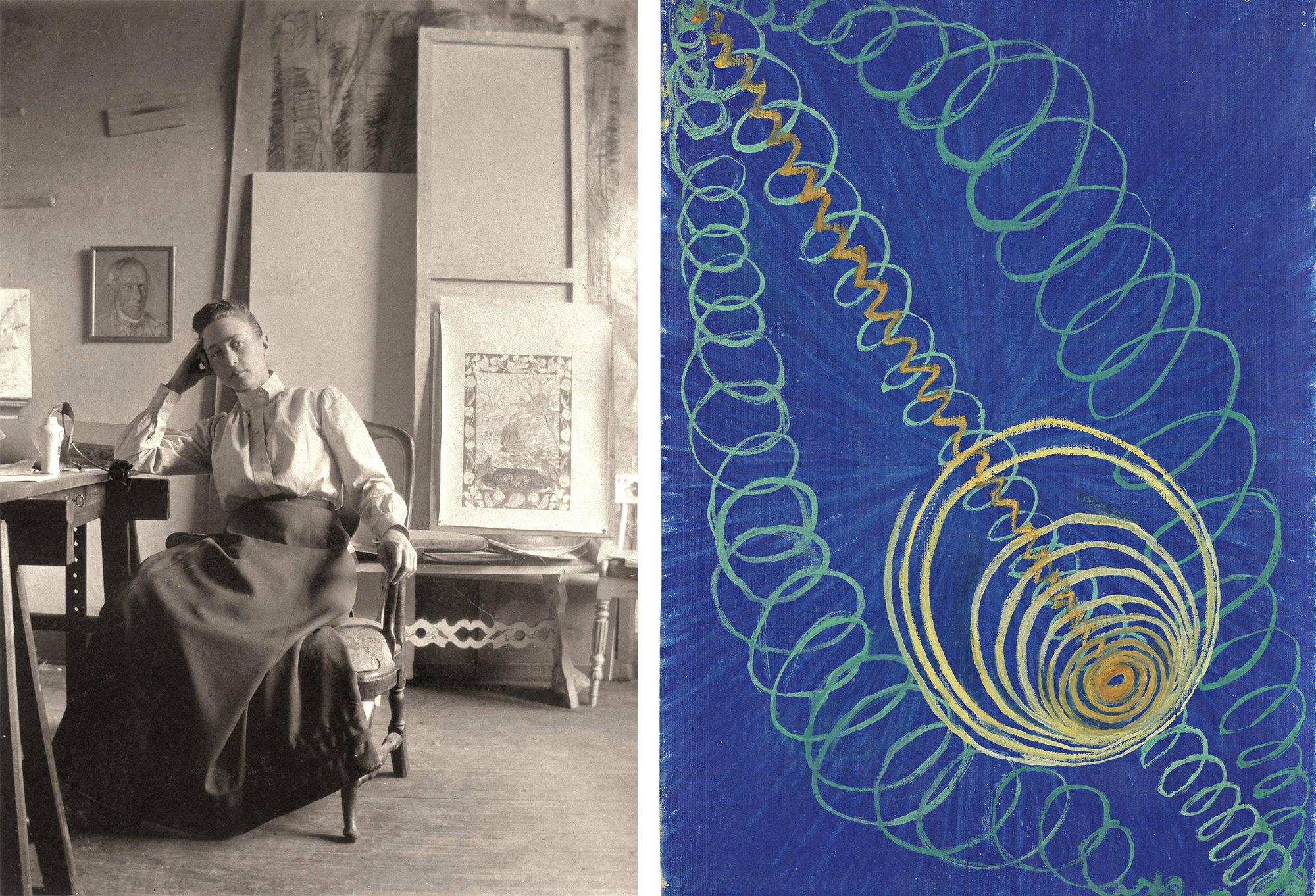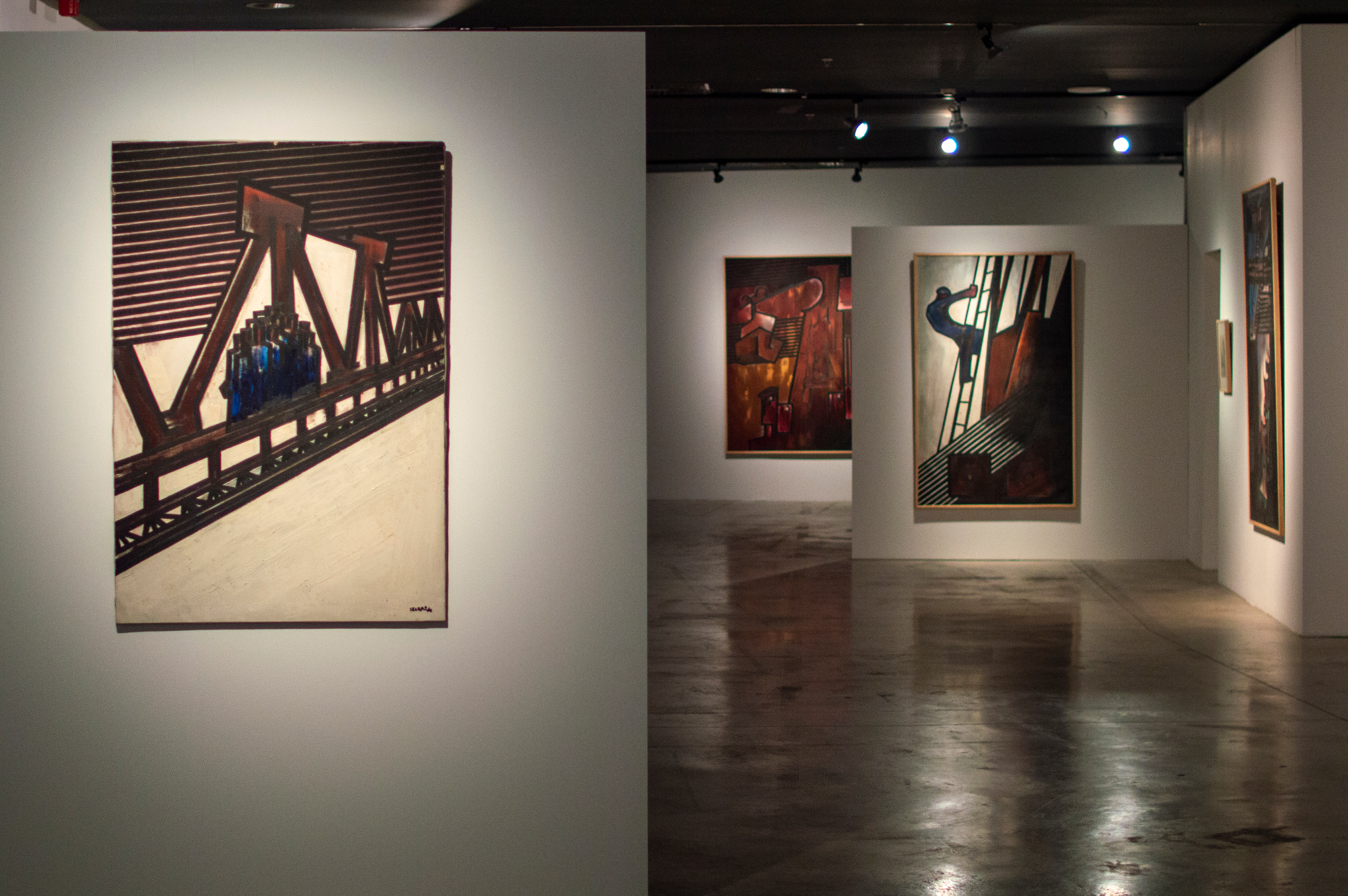"I'm in the factory for 25 years every weekend, but that allows me to be in the workshop on working days."
- Every time I walk through the Arrosadia district of Pamplona I get my head in the workshop of Santa Marta Street. Usually, Montse inserts the brush into the tarrito, removes almost all the paint from a rag and spreads the brush onto the canvas, into the loop. Today I entered into his space-time, and as I smoked the cigarette before the conversation, he told me, looking at the painting I was working on: “Fifteen years looking at a wall, then you have to be crazy…”.

Montse Borda Olague
Villava (Navarra), 1961
Born under Franco, in Villava (Navarra), with a population of 3,000 inhabitants. In the nearby environment he did not have artistic references, but from a very young age he began to write, to play music… He decided to start studying at the School of Art and Design of Pamplona at 23 years old and the two parents dead, he did not want to dedicate his whole life to hospitality. To dedicate time to painting, spend the weekends working under payroll, cleaning a factory.
How did he come here?
I started writing when I was very young. For years, I've come across my personal and social problems and I've been transcribing them. The fact is that when I was 20-21 years old, a Pamplona painter named Javier Jiménez Monreal [from Madrid] took me to the Prado Museum. And I want to mention Javier Jiménez Monreal, who, despite being a tremendous painter, has not been recognized here, was from the evicted and lived on the street. When I entered Pradora and saw Velázquez, Goya, Rembrandt…, I didn’t look at each other’s work, but I realized that everyone was doing what they wanted. Velázquez painted like Velázquez, like Goya Goya, like Grecok Greco… There I saw my opportunity and thought: “What I do will also be what I want, here everyone is himself, so I can be myself.”
I worked in the hospitality industry, I was 23 years old and my parents were dead. Back in Madrid I thought I couldn't live like that, so I started studying at the School of Art and Design in Pamplona. There I met with very good teachers: Isabel Baquedano, Salvador Beunza, Juan José Aquerreta… So I said that I wanted to be in a workshop and that my life was that. Since then I have always had a workshop. There I rest, work, try and suffer. It's my cave, and I need that cave.
I spent the next 20 years teaching, but the birth of my daughter Haizegoa forced me to be more at home, because my partner's working hours were complicated. I started working at the factory on weekends, until today. I've been working at the factory for 25 years every weekend, but that allows me to be in the workshop from Monday to Friday.
Why do you paint?
I always say I pray for necessity. And I would say that any art I could do, whether it's dance, music -- I would do it by necessity. This world that we have gives no more: you have to go to work, the relationships that you have to have are also regulated… That is a need to stop. I see it as the need to get out of society.
The times outside this workshop and here inside are not the same. What do you have to do with time?
No, they're not the same at all. And time is important, but I call it space-time. Because I can take ten minutes here [to the workshop] and give two strokes to a painting. That's time, but not time. It's time for you to come here and maybe you're not painting, maybe you're looking at the play or you're reading something. Having a distance of 4-5 hours allows you to get here and do things calmly.
Here the world stands and I don't have to fight anything other than myself. I have no more than the white tongue here. That and one goal. Technical, I have to go very slowly, here in the world people's times are not worth it.
I don't know anything about painting, but I've only heard the brush technique seco.Es
a technique that exists, but I've adapted it a little for me. I was lucky enough to attend a course by José Miguel Corral and there he taught us to work with charcoal, just with that. But I got to the workshop and, you don't ask me why, I thought if I mixed this coal with flaxseed oil and I started working with the dry brush technique, I could do something.
I started making little portraits: of my daughter's friends, of the time of the ikastola… and I was giving away. What's more, at first I made them with pure coal. I later came up with oil. And the technique of the dry brush, unlike the oil, is not to paint directly with paint: it is to take the paint, rub it on a rag and re-rub the brush, almost dry, in the painting. We can say that what you take is not painting, but a little pigment. A layer, then, appears on the canvas and, if you are anointed again, a darker layer. The degree of darkness observed in the table depends on the amount of layer. I've also come to give 80 layers.
In addition to coal, you've also used fat.
Yes. As I said before, I spend here on working days, but I have been cleaning a factory for 25 years on weekends. The factory was already a place known to me and had some of the pieces that were produced in the factory, which I liked. I once found some boxes and realized that the muse was up to my eyes. The interior of the box was a repeated piece that produced rhythm and harmony. So that I wouldn't see myself, I took one of those boxes and headed to the sink with my cart. A good photo was enough.
Of course, the idea was to paint paintings with the same fat you get when you clean the machines. When collecting the fat, filtering it and working it with the dry brush, it is small and not contaminating. Then it stays like an engraving. And so I can turn the residue into a work of art.
I wanted to make a series of 11 paintings, and I made a project proposal to the factory itself. They nodded. And it's funny, because my paintings are hung right on the same corridor that I'm still cleaning up now. It's me who cleans the crystals from my paintings. In three years' time I will retire at the factory and personally it is important to think that my paintings will continue there even if they do not continue to clean.
If instead of being in the factory you were working elsewhere, do you think you would find the ideas to bring it to the workshop the same way?
Yeah, it's happened to me. This summer I have been in the pools in Barañain and since then, the issue of children is a subject that I am quite aware of. I'm always looking for that link. what fascinates me from where I am? They can be tree leaves or childhood faces. I'm always looking for beauty. This world is so repugnant, we are all so selfish and so greedy, that the only way to protect myself from all of this is to stay in beauty, in balance, in rhythm.
You told me earlier that we won't find you painting dead landscapes or bees.
I started to explain the political issues from my first series: I started working women on the same stone. The second series also revolved around women. At this point, I put my focus on the looks, on the portrait. They were all inspiring to me: young people, adults… One look told me something and the moment I decided I had to paint.
Claude Cahun has been one of the most important characters in music history. In Estella I was asked for a dry brush course and as a thank you I was presented with the book Women Artists: 19th century and 20th century. When I started looking at the book, everything was normal for me, until the woman appeared. “But what is this?” I thought from the beginning. I sat down and I was very curious about it. I thought I was going to be a person today, but when I started reading his life and saw that I was born in 1894, I flipped. It is a life that, from the present and from here, may seem common, but that was presented a hundred years ago, among other things, as non-binary before the world.
She lived with her sister, both of them were lovers from a very young age. He came out of such internalized roles: you are a woman, you are a man… For him it was always a debate his character, I think that is what he means with his photos. It must also be said that he belonged to a high-class family.
After reading all that, thinking that I have lived in the Mass, in the Rosary, in the nauseating Francoist schools of the time… All regulated: to be obedient, to be the perfect woman at home, to marry and to have children… When I knew there were people like Claude Cahun, I thought: “But in what deceptions have we lived?”
Do you always work on order?
Not always. For example, I made the series of female looks, which I have already referred to, because I wanted to. Because it moved me. I knew it was going to take a couple of years, but I believed in the project and I just needed two things: looks and space time. Sometimes I found those looks, sometimes I found myself. Claude Cahun is one of those women I painted and at the time the exhibition was exposed a person who saw Claude's painting and was willing to buy. Two years later he came to the workshop and told me he wanted to portray fifteen of him. And I was happy. Because I was already in touch with this character, because I knew her life, almost as if I met her personally.
Have you ever rejected any orders you've ever been offered?
Yes. I remember once being proposed a landscape project. It has happened from time to time, but by doing what I wanted I have gone ahead economically and saying that not painting to paint is a saving of energy. I'm mostly dedicated to portrait. I have collaborated, but I try to work on the issues that come out of me.
Would you like not to need the factory?
Yes. In the art world, there's usually no payroll for a month. The interest in purchasing paintings in a Pamplona is almost nil. Because I have now been lucky and found the seed among the straws, but nevertheless trying to live from this is almost impossible. You can do what a Iosu shoe does: paint shop windows, make the stars of Christmas trees… But I chose the model: a small payroll in the factory to guarantee the minimum toilet.
I'd like to live on this alone, as long as the things I love are done. Liking your job doesn't mean that work isn't hard, for example, this is very hard. And it seems that if you enjoy doing it can't be called work. Once in a clean-up psychiatrist, a local psychiatrist asked me if I would give free workshops when I knew I was painting. I answered nicely, but I told her that I should buy panties and food like any other.
Would you say these square meters are more domestic than your home?
When I go to the Old Town I always leave here. When I come back from work, I come here first and then home. I mean, this is always the reference. It's my cave, my house, yeah. The house exists, but I am here. This is the place I'm in. My daughter, my partner or washing machine, the pans… Here no, here
alone yo.Este space saves for me, besides, the works done throughout my life. And it happens to me that when I look at an old job, even if I've been 40 years old, I still identify with him and he brings to my head the excitement and the illusion I had. Rather than him, it is my work that speaks of me. It's my work that tells me who I am. Because I wanted to paint that silence or that character and not another.
Your social environment also revolves around art.
Yes. I remember when I was a young man talking a lot to a friend who is a musician, Peio Otano, that we would need a school that brings together all the artistic disciplines. For me, all artistic disciplines have the same basis: rhythm and harmony. So, theater, dance, music -- why differentiate it? If I had started in music school now I would have dedicated myself to that, as if I had started dancing. Here I ended because it was easy for me to get pencils or brushes.
If there is something that I don’t ask you and you don’t want to leave without saying…
I’d like to talk about artist. I don't like anything. Nothing. I call it "painter" or "shoemaker" or whatever. If the word artist has something to do with the word creation, we are all artists. Every morning they put a foot on the floor and say, "What am I going to do today?" Another thing is that after a workshop I don't know how many years you know a specific trade, so you're an artisan. I'm a painting artisan. But I don't know who said it, in this life it only gives you time to be an amateur.
Then there's another thing: that people who don't see themselves identified with the word artist think they don't have that gift. And that's not true. A housewife who has worked for 40 years will be an artist in that landscape who has worked for so long, but it is not because she was born with the gift of doing all the housework well. Work will bring you the muse. The muse does not appear, the muse is here, in the workshop, in this space-time.
Bussum (Netherlands), 15 November 1891. Johanna Bonger (1862-1925) wrote in his journal: “For a year and a half I was the happiest woman on earth. It was a long and wonderful dream, the most beautiful one I could dream of. And then came this terrible suffering.” She wrote... [+]
























